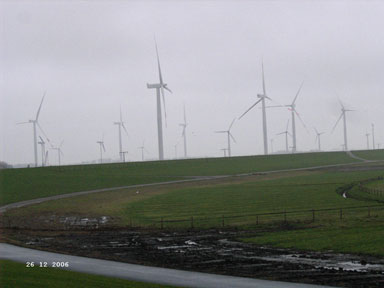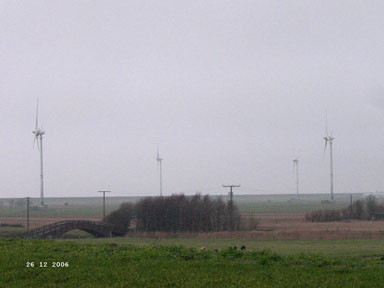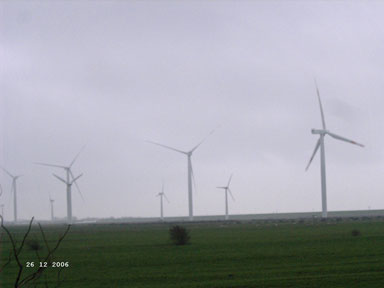January 9, 2007
Different sizes of windmills
When Dryden passed a renewable energy law in October, it expressly aimed at small-scale windmills providing power that is mostly consumed on site, rather than large-scale windmills designed to produce power that is fed into the electrical grid.
(An earlier battle over Cornell's now-cancelled plans for a large-scale wind farm on Mount Pleasant demonstrated that large-scale projects will face substantial opposition here.)
I recently had an opportunity to see the industrial windmills in action, in a variety of sizes. We visited Emmelsbüll, a village in North Friesland, near the Germany-Denmark border. On the train from Hamburg there were lots of windmills, and I was trying to guess their sizes, but when we arrived I could really see them.
It turns out that there are multiple sizes of windmill in use, and they're often mixed up within the same project. While the village pastor told me that investors apparently only want to build the 100-meter windmills, which produce the most power, there are lots of smaller windmills still in operation. Wind comes off the North Sea nearly constantly, along with rain and fog, and farmers find the windmills a profitable addition to their drenched fields.

Mostly larger (100m) windmills near the North Sea.

Smaller windmills (~50m) near the North Sea.

A range of windmill types near the North Sea.

Aerial view of smaller windmill.*
The windmills spun and rotated with the wind, though not all of the larger ones were actually operating yet. The smaller ones were closer to the road, and I could hear some noise, kind of like a washing machine, probably from the turbine.
Aesthetically, I have to say that I found the smaller windmills okay - not great, but tolerable - while the newer 100-meter ones loomed ominously and really did look like "schoolbus-on-a-stick". The smaller windmills had shorter, more rounded turbines, and the scale of their construction let them rest more lightly on the landscape. I can't say that I really liked the look of huge numbers of these things. A single windmill can be elegant; dozens of them is definitely cluttered.
Overall, seeing these windmills left me in about the same place I'd been before - strongly supporting small-scale windpower, but finding industrial-scale windpower much less exciting. Seeing these things for real left me wondering even more about the wisdom of giant structures needing cranes for repair, and wondering how long it takes to make back the energy cost of building (and maintaining) them.
* - If you look closely, you can see that this picture is really from Miniatur Wunderland, an enormous HO-scale model railroad layout in Hamburg. The rest of the pictures are from Emmelsbüll. The pastor I spoke with is Angelika's brother-in-law, and we really went up there to visit her family, not to study windmills.
Posted by simon at January 9, 2007 8:49 AM in energyNote on photos
Personally I feel that the windmills in Nordfriesland are a great addition to the landscape. It would be unbearably boring otherwise.
You`re right. I hate the windmills. They are not only ugly but noisy.
What about a rainwater generator?
Rainwater generator is defintely something to be considered. Do they already exist?
those are not windmills!!!